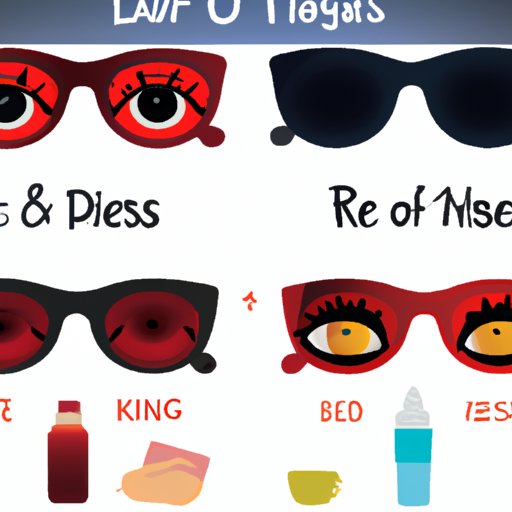Introduction
Red eyes can be a sign of an underlying medical issue or simply caused by lack of sleep or too much exposure to screens. Understanding the causes and symptoms of red eyes can help you take the necessary steps to prevent them and keep your eyes healthy. This article will explore the causes and symptoms of red eyes, as well as prevention tips to help stop your eyes from being red.
Get Plenty of Sleep
Getting enough sleep is one of the most important steps you can take to prevent red eyes. Adequate rest helps keep your body and mind functioning optimally, and it also helps keep your eyes healthy. When you don’t get enough sleep, your eyes become dry and irritated, which can lead to redness.
Benefits of Adequate Rest
Adequate rest has numerous benefits for your overall health and well-being, including improved cognitive function, better mood, increased energy levels, and lower stress levels. It also helps keep your eyes healthy and reduces the risk of developing red eyes.
Tips for Getting Enough Sleep
To ensure you get enough sleep each night, try sticking to a consistent sleep schedule. Go to bed and wake up at the same time every day, even on weekends and holidays. Avoid caffeine, alcohol, and nicotine in the evening, and limit your screen time before bed. Make sure your bedroom is dark, cool, and quiet to create an environment conducive to sleep.
Wear Sunglasses
Wearing sunglasses when outdoors can help protect your eyes from the sun’s harmful UV rays, which can cause redness. Wearing sunglasses also helps reduce glare, which can be uncomfortable and cause your eyes to become strained and irritated.
Benefits of Wearing Sunglasses
Wearing sunglasses helps protect your eyes from the sun’s ultraviolet (UV) rays. UV radiation can damage the delicate tissues in your eyes, leading to redness, irritation, and even vision loss over time. Wearing sunglasses also helps reduce glare and improves your vision in bright light.
Tips for Choosing the Right Pair
When choosing a pair of sunglasses, look for lenses that offer both UVA and UVB protection. Choose a pair with a wide frame to provide the most coverage. If you plan to wear them while driving, look for polarized lenses to reduce glare. And if you’re looking for a stylish pair, opt for a classic shape and color.
Use Eye Drops
Eye drops can help reduce redness and irritation in your eyes. They are available over-the-counter and can be used to treat a variety of conditions, including allergies, dry eyes, and pink eye.
Benefits of Using Eye Drops
Eye drops can help reduce redness and irritation in your eyes by lubricating and soothing the tissue. They can also help flush out allergens and bacteria, which can cause redness and irritation.
Tips for Choosing the Right Eye Drops
When choosing an eye drop, read the label to make sure it is appropriate for your condition. If you have allergies, look for eye drops that contain antihistamines. For dry eyes, choose a lubricating drop. And if you have pink eye, opt for a drop that contains antibiotics.
Avoid Rubbing Your Eyes
Rubbing your eyes can make redness worse, so it’s important to avoid doing it. Rubbing your eyes can irritate the delicate skin around them and spread bacteria, which can lead to infection and further redness.
Reasons to Avoid Rubbing Your Eyes
Rubbing your eyes can make redness worse, as it can increase irritation and spread bacteria. It can also damage the delicate skin around your eyes, leading to wrinkles and other signs of premature aging.
Tips for Keeping Your Hands Away
If you find yourself wanting to rub your eyes, try to distract yourself with another activity. Take a few deep breaths and focus on something else until the urge passes. You can also apply a cold compress to your eyes to reduce redness and irritation.
Reduce Screen Time
Spending too much time looking at screens can strain your eyes, leading to redness and fatigue. To reduce the risk of developing red eyes, it’s important to limit your screen time and take regular breaks.
Reasons to Limit Screen Time
Staring at screens for prolonged periods of time can strain your eyes and lead to redness and fatigue. The blue light emitted from screens can also disrupt your circadian rhythm, making it more difficult to fall asleep at night.
Tips for Taking Breaks While Using Screens
To reduce the risk of developing red eyes, it’s important to take regular breaks while using screens. Every 20 minutes, look away from the screen and focus on something else for at least 20 seconds. You can also set a timer to remind yourself to take breaks.
Conclusion
Red eyes can be caused by a variety of factors, including lack of sleep, too much exposure to screens, and inadequate protection from the sun. To prevent red eyes, it’s important to get plenty of sleep, wear sunglasses, use eye drops, avoid rubbing your eyes, and reduce screen time. If your red eyes persist, seek professional medical help.
These tips can help you keep your eyes healthy and free of redness. Remember to stick to a consistent sleep schedule, wear sunglasses, use eye drops, avoid rubbing your eyes, and limit your screen time. Following these simple steps can help keep your eyes healthy and reduce the risk of developing red eyes.
(Note: Is this article not meeting your expectations? Do you have knowledge or insights to share? Unlock new opportunities and expand your reach by joining our authors team. Click Registration to join us and share your expertise with our readers.)
